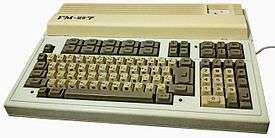FM-7
The FM-7 ("Fujitsu Micro 7") is a home computer created by Fujitsu. It was first released in 1982 and was sold in Japan and Spain. It is a stripped-down version of Fujitsu's earlier FM-8 computer, and during development it was referred to as the "FM-8 Jr.".
 | |
| Manufacturer | Fujitsu |
|---|---|
| Type | Personal Computer |
| Release date | November 1982 |
| Introductory price | ¥126,000 (Japan) $1250 (USA) |
| Discontinued | April 1984[1] |
| Units sold | 220,000[1] |
| Media | Cassette tape, 5¼-inch floppy disk |
| Operating system | Fujitsu Disk Basic , OS-9, FLEX |
| CPU | 2x MBL 68B09 clocked at 2MHz |
| Memory | 64KB RAM, 48KB VRAM, 48KB ROM |
| Display | 8 colours at 640 x 200 pixel resolution |
| Input | Keyboard, Joystick |
| Dimensions | 43.2 x 28.5 x 10.2 |
| Mass | 4.5 kg |
| Predecessor | FM-8 |
| Successor | FM Towns |
| Related articles | TRS-80 Color Computer |
Although it was designed to be a cut-down version of the FM-8, most notably removing the (expensive) bubble memory technology, the FM-7 was given a more advanced AY-3-8910 sound chip capable of three voice sound synthesis, leading to a strong uptake among the hobbyist computer market in Japan and making it a more popular system than the FM-8.
The FM-7 primarily competed with the NEC PC-8801 and Sharp X1 series of computers in the early 1980s. It was succeeded by the FM-77 series of computers in 1984, which featured backwards compatibility with the FM-7. The FM-77 series was later succeeded by the 32-bit FM Towns in 1989.
The FM-7 is based around the 6809 chip, which was also used in home computers such as the TRS-80 Color Computer and Dragon 32/64, as well as several arcade games.
Hardware
- Two MC 68B09 CPUs @ 2 MHz: one main CPU and one graphics processor.
- Screen Resolution: 640×200, 8 colors
- Memory: 40 KB ROM, 64 KB RAM
- Sound: 3-channel (AY-3-8910) PSG chip, built-in speaker mounted near the top of the unit. From fm77 av onwards, 6 channel ym2203 (3psg+3fm)
- Interfaces: RS-232, monitor and Centronics ports, 3 expansion slots.
- Storage: 5.25" floppy disk
- Operating system: OS-9, (compatible with Color Computer)[2]
- Three slots for optional plug-in cards, including a Z-80 CPU and additional RS-232 ports.
- Full-size keyboard, with keys handling multiple functions (as many as 5, depending on what SHIFT/KANA/GRAPH/etc key is pressed).
- 10 Function Keys at the top, pre-programmed with shortcuts (LIST, etc.).
- Numeric keypad (on right) and cursor-control keys (upper-right).
F-BASIC
The included "F-BASIC" is an enhanced version of the Color BASIC language used on the TRS-80 Color Computer. Changes include a different character set that includes katakana and a few kanji, the ability to have graphics appear on the default text screen, and several new commands such as BEEP, CONNECT, MON, SYMBOL, INTERVAL, MERGE, RANDOMIZE, SWAP, and TERM. There are also strings for TIME$ and DATE$, which access a temporary built-in internal clock, though if the power is turned off, the time and date are lost.
It's worth noting that, while F-Basic has commands that Color BASIC does not, most commands featured in both versions of the language operate in exactly the same fashion.
While the BASIC EDIT command works the same as on Color BASIC, the cursor position is important on the FM-7: there is a small keypad on the upper-right of the FM-7 with cursor-control keys (arrows, INSERT & DELETE), and wherever the user decides to position the cursor, it will move it there and affect whatever is underneath it.
Both Microsoft and Fujitsu share the copyright on the BASIC.
Models
There were several models of the computer:
- 1982 — FM7: M68B09, RAM 64 kb, ROM 48 kb, vram 48 kb, 640×200, 8 colors
- 1984 — FM New7: M68B09 integrated memory and LSI chip (cheap production). The features are the same as the FM-7.
- 1984 — FM77: M68B09E, RAM 64 kb (max 256 kb), vram 48 kb
- 1985 — FM77L2, M68B09E
- 1985 — FM77L4, M68B09E
- 1985 — FM77AV: M68B09E, ram 128 kb (max 192 kb), rom 48 kb, vram 96 kb, 640×200 (8 colors), 320×200 (4096 colors), 4096 colors, 1 (AV-1) or 2 (AV-2) floppy 3.5-inch 320 kB
- 1986 — FM77AV20: M68B09E, like l'FM77AV but: floppy 640 kB
- 1986 — FM77AV40: M68B09E, like l'FM77AV20 but: ram 192kb (max 448 kb), vram 144 kb to support 320×200 (262144 colors)
- 1987 — FM77AV20EX: M68B09E, ram 128kb (max 192 kb), vram 96 kb, 640x400 ?
- 1987 — FM77AV40EX: M68B09E, ram 192kb (max 448 kb), vram 144 kb, 640x400 ?
- 1988 — FM77AV40SX: M68B09E, ram 192kb (max 448 kb), vram 144 kb
References
- 小林紀興 (1987). 富士通の大逆襲計画 [The big counterattack plan by Fujitsu] (in Japanese). 講談社. p. 95. ISBN 4061928074.
- Larry Green (2005-04-08). "The Fujitsu Micro FM7 - Larry Green's Homepage at Nausicaä.net". Retrieved 2009-03-02.
External links
- Fujitsu FM 7, OLD-COMPUTERS.COM Museum
- The Fujitsu FM-7, 8-Bit Computer Page, Larry's Homepage
- Oh!FM-7 museum